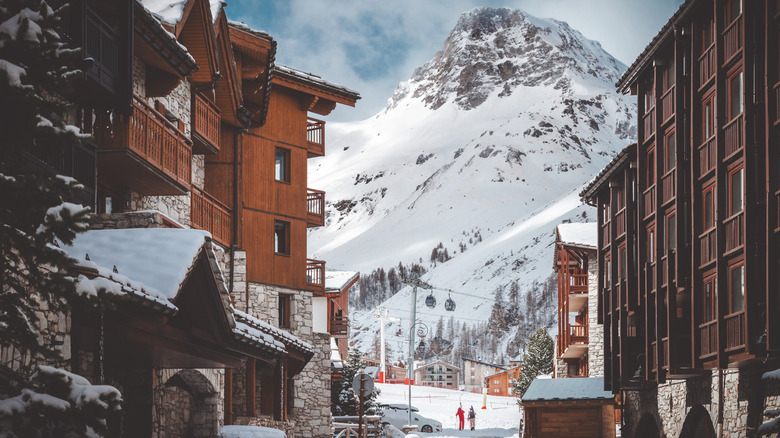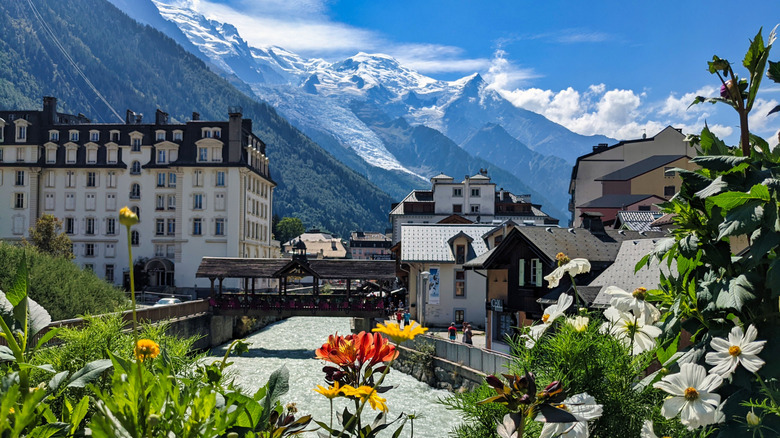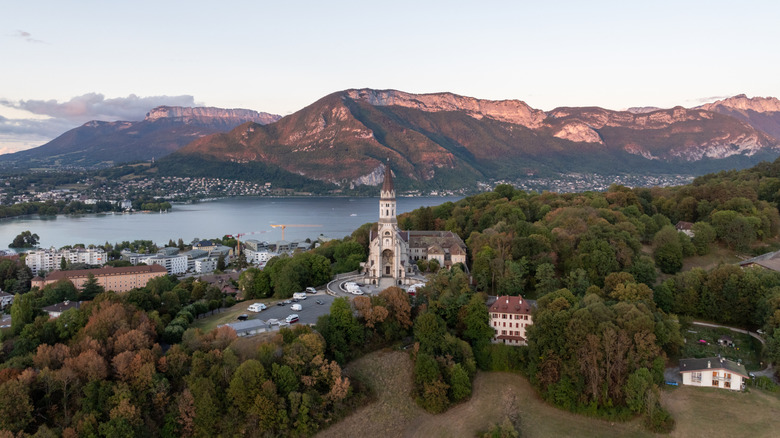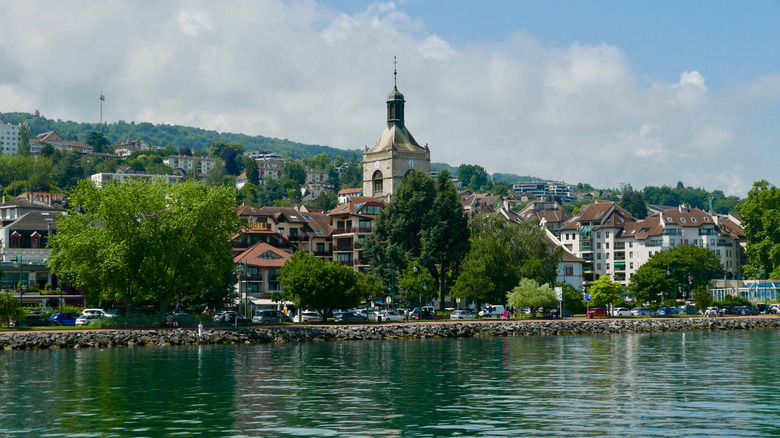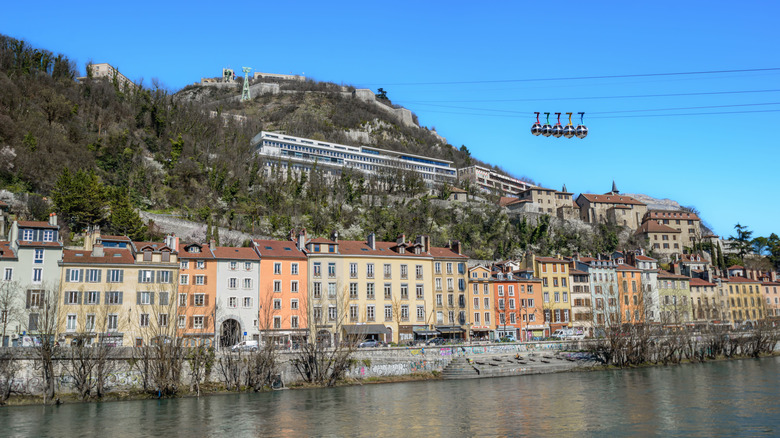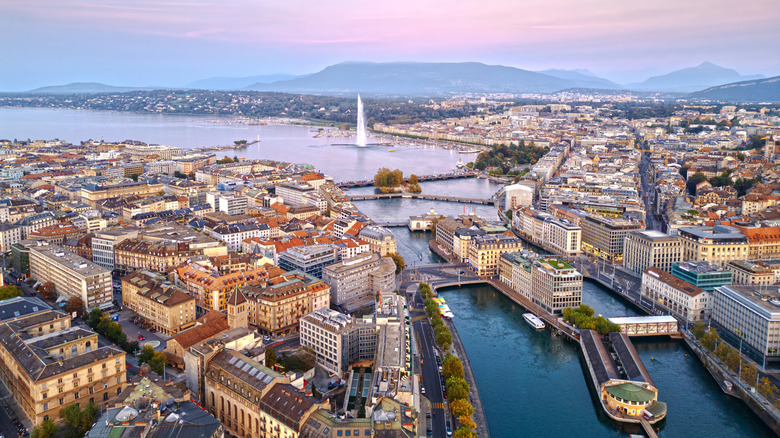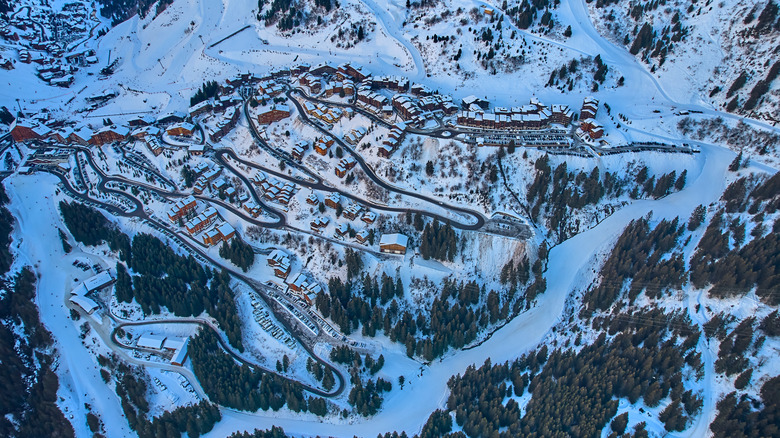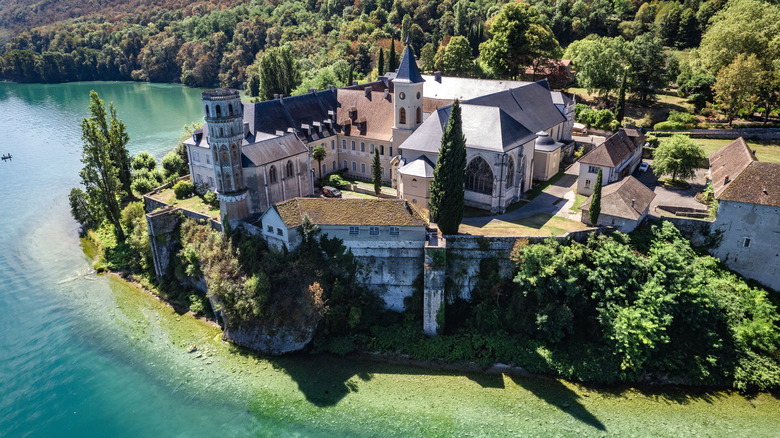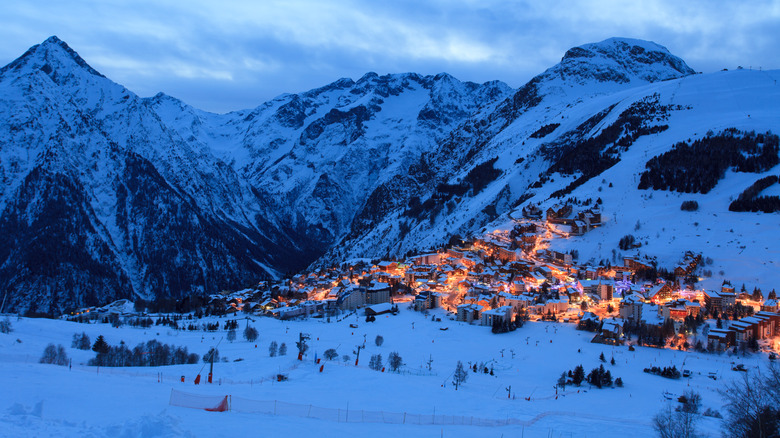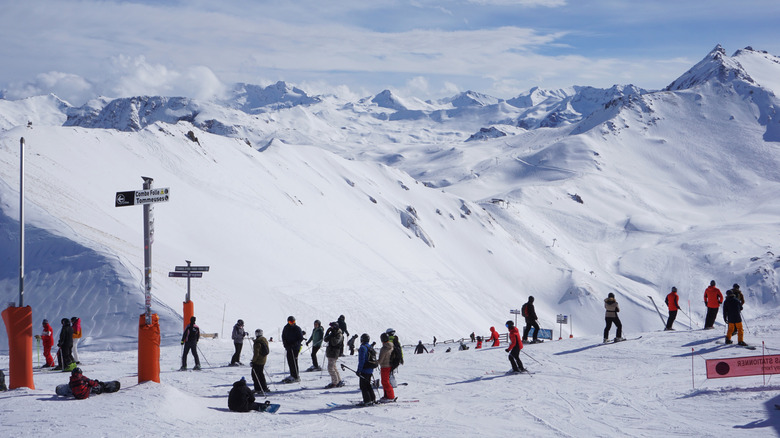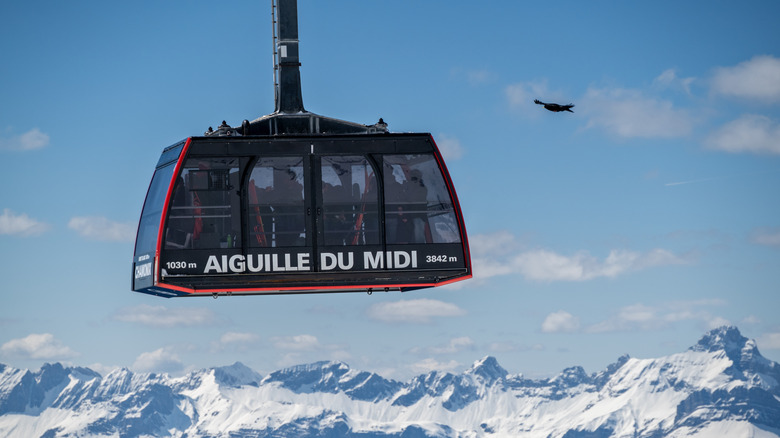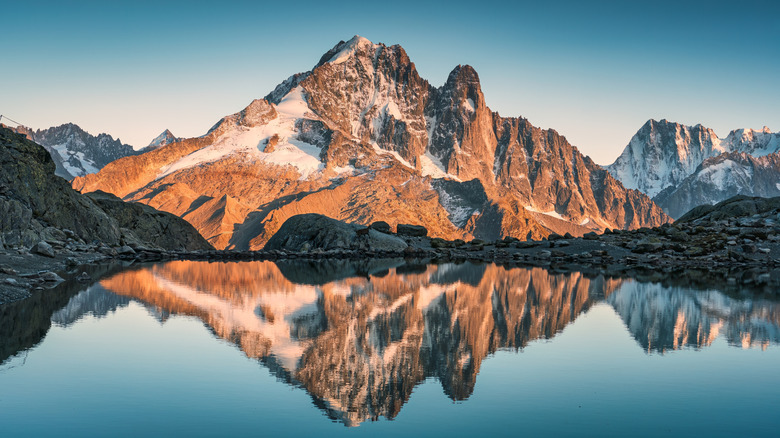The French Alps Offer Amazing Attractions And Activities To Experience
The French Alps are unique among all of Earth's destinations in that they boast arresting natural beauty combined with towns that offer world-class indulgence. Home to many of the best French destinations to add to your winter bucket list, you can't go wrong booking your next holiday in this region. Here, you can spend your morning scaling a glacier before returning to your chalet to enjoy an evening sipping champagne at a Michelin-starred restaurant. In the French Alps, rugged Alpine architecture and scenery meet refined culture, where even the most daring daily excursions are followed up with a luxurious après-experience. Even the Cary Grant and Audrey Hepburn film, "Charade," was famously filmed in the French Alpine town of Megève.
In this guide, we'll explore 10 of the French Alps' best destinations and attractions for tourists. Carefully selected for travelers who want a combination of comfort and excitement, you'll find legendary ski towns like Chamonix and Val d'Isère, wellness-centered destinations, high-altitude dining experiences, and iconic alpine summits to remember for the rest of your life. Whether you're a seasoned mountain hiker, a foodie in search of some of the world's best restaurants, or simply a traveler enjoys the finer things in life without sacrificing natural beauty, the French Alps are a must-visit.
Chamonix-Mont-Blanc
Built at the foot of the impressive Mont Blanc — the 11th tallest mountain in the world, and the tallest in Western Europe — Chamonix is where alpine adventure was born. More affordable than some of its Swiss Alps counterparts, this world-famous mountain town was the birthplace of mountaineering for explorers and adventurers in the 18th century, after a reward was offered to the first person who could successfully reach the top of Mont Blanc.
Today, Chamonix is still a veritable playground for adrenaline junkies with a passion for Alpine culture. One of the town's most beautiful experiences is the Panoramic Mont Blanc cable car. Offering aerial views of glaciers and snow-capped peaks, it takes visitors on a 50-minute one-way journey that crosses into Italy.
Adventure in Chamonix doesn't stop with the cable car, though. Glacier hiking in the Vallée Blanche offers the once-in-a-lifetime opportunity to walk on centuries-old ice that is soon expected to disappear completely due to climate change. Meanwhile, paragliding flights over Mont Blanc are an exhilarating way to experience the beauty of the region. There's also the epic Tour du Mont Blanc hike, a multi-day affair that will leave an indelible mark on you. After your daily adventure, you can retire to the center of Chamonix to enjoy some of the resort town's five-star hotels and restaurants. Atmosphère and Le Matafan are both recommended for diners by the Michelin Guide, while the beautiful Auberge Du Bois Prin hotel enjoys exceptional reviews.
Annecy
Annecy is one of the French Alps' fairytale towns, with its pastel buildings on cobblestone streets, flower-laden bridges, and a lakefront filled with rowboats. Often called the "Venice of the Alps," this enchanting town offers visitors a combination of culinary greatness, picturesque scenery, and Alpine culture. It is an idyllic stop for nearly any type of travel party — including families with young children, couples looking for romance, and even solo travelers in search of the world's most stunning sights.
If you're looking for a leisurely activity, stroll along the Thiou River to take in the city's bridges, like the famous Pont des Amours, or Lover's Bridge. Then, wander through medieval streets in Old Town. The Palais de l'Ile, the residence of the Lord of Annecy in the 12th century, and the Musée-Château, constructed in 1219, are two of the most incredible buildings in this neighborhood. Also make sure to check out the Queen's Tower, the oldest part of the Musée-Château's structure.
For food lovers, Annecy offers over a dozen Michelin-recommended restaurants serving everything from the creative "locavore" menu at Le Clos des Sens to line-caught local fish at L'Esquisse. If you're in the mood for something less Alpine, consider Japanese hotspot, Minami, near Old Town. As one of the most underrated destinations in France, Annecy is a great place to spend a weekend renting a paddleboard, biking around Lac d'Annecy, and browsing the city's various markets. Travelers can also tour five castles in the area: the Château of Annecy, the Château of Menthon-Saint-Bernard, the Château of Duingt, the Château of Montrottier, and the Château of Clermont, one of Annecy's only examples of Renaissance architecture.
Évian-les-Bains
On the shores of Lake Geneva, travelers will find the elegant resort town of Évian-les-Bains. Best known nowadays as the source of Evian mineral water, the town first rose to fame in the late 18th century thanks to the purported healing properties of its waters. Today, modern visitors flock to the city not only to drink from the source, but also to experience Évian's natural beauty, intriguing history, and luxurious spa culture. Specifically, the town's History Trail takes tourists on a journey from medieval times through the Belle Époque, which was considered the golden age of thermal spa tourism in Europe.
Among the most popular buildings in Évian-les-Bains is the Palais Lumière, one of the town's most iconic landmarks. Inaugurated in 1902, the Palais Lumière was originally a hydrotherapy bathhouse. Today, functions as a cultural center and exhibition space, and guests can tour the facility year-round, soaking in the architecture and enjoying its multimedia library.
Another must-see is Buvette Cachat, the center of Évian-les-Bains' social scene after this iteration of the building opened in 1905. Resembling something in Oz's Emerald City, Buvette Cachat could have easily been one of the sets for "Wicked." Today, the building is not open to the public, but it's still worth stopping by to see the exterior of this Art Nouveau masterpiece. Finally, make sure to check out the lakeside promenade, where you can explore historic grand hotels. The Hôtel Royal Evian, for example, offers high-end on-site dining, generously sized rooms, and treatments at a spa completed in 2024. Part of the larger Évian Resort, guests can also opt to stay at two other accommodations, Hôtel Ermitage or Hôtel La Verniaz.
Grenoble
Situated at the crux of a trio of mountain ranges, Grenoble offers traditional Alpine adventure and plenty of cultural activities — a combination that has earned it the nickname "Capital of the Alps." This is the perfect destination for solo travelers with split personalities, or couples with distinctly different interests. Visitors to Grenoble can spend the morning skiing rugged trails or mountain biking, while the afternoon can be dedicated to meandering through world-class museums, perusing local boutiques, and exploring historic districts.
In fact, the city's Old Town neighborhood offers several architectural gems. This includes Notre-Dame Cathedral — which features a mash-up of Romanesque and Gothic styles — as well as the beautiful Palais du Parlement du Dauphiné, on which construction began in the 1400s. Meanwhile, art lovers will want to spend time at the Grenoble Museum of Art, home to one of Europe's best collections with pieces from Chagall, Matisse, Monet, Picasso, Warhol, and more. There's also the annual spring Street Art Fest Grenoble-Alpes, which started in 2015 and has led to the development of an impressive 235 permanent walls for artworks.
Today, however, one of the city's most well-known attractions is the Bastille cable car, which visitors can ride to the historic Bastille fortress. First opened in 1934, the cable car has served millions of tourists over its 90-year history. From the top, you'll have spectacular views of the city below and the surrounding mountains. During the winter months, Grenoble also offers easy access to several popular ski resorts in the Isère region, such as Chamrousse and Le Sappey-en-Chartreuse.
Lake Geneva
Crossing into both France and Switzerland, Lake Geneva — or Lac Léman in French — is one of Europe's most dazzling natural features. It's also the perfect destination for travelers who want to enjoy the best of the Alpine lifestyle without having to hike up a mountain. On the French side, in addition to the must-see Évian-les-Bains, travelers should pay a visit to Thonon-les-Bains. Another town that grew to spa tourism prominence during the Belle Epoque, Thonon offers a variety of lovely sites — including Paul Jacquier Square, Bellegarde Castle, and Le Square Aristide Briand.
Meanwhile, if you take a cruise to the Swiss side of Lake Geneva, you'll find Lausanne and Montreux. Both of these cities are part of the "Swiss Riviera," where travelers can enjoy lakefront promenades with gardens and statues, delicious bakeries in historic buildings, and, in Montreux's case, its popular summer jazz festival.
Oenophiles are sure to enjoy the Lavaux Vineyard Terraces, a UNESCO World Heritage Site. Some of the vineyards in this wine region trace back to the 11th century, when Benedictine and Cistercian monks maintained them. Today, there are 14 villages in the Lavaux area, but Dézaley and Calamin are widely regarded as the gems for wine enthusiasts. Pair your wine tasting trip with restaurants like the Mediterranean-inspired Ottolenghi and the Michelin-starred Il Lago. Between the scenery, the dining, and the luxury boutiques, Lake Geneva is as perfect a French Alps vacation as any traveler could dream up. And, if you're stuck stateside, considering Wisconsin's own Lake Geneva on a scenic road trip until you can book your next European adventure.
Méribel
At the center of Les Trois Vallées, one of the largest ski areas in the world, Méribel is the quintessential French Alps ski resort. With classic chalets, pine forests, and picture-perfect scenery, this upscale location is still family-friendly enough for those traveling with children. It was even awarded the Famille Plus designation.
As a whole, Les Trois Vallées offers more than 370 miles of ski slopes, making it ideal for all levels of skiers. There are even learning areas and fun zones designed specifically for beginners. Off the slopes, travelers will find après-ski options to suit every taste, from traditional pubs to chic cocktail bars. As with many towns in the French Alps, there are also Michelin-recommended restaurants like Le Cèpe, which takes pride in its affordability, and the ultra-stylish La Coursive des Alpes, set in the town's former movie theatre.
Unlike its glitzy neighbor Courchevel, Méribel doesn't require flash in order to fit in. Travelers can simply enjoy themselves when they are here. Outside of skiing, there are plenty of fun outdoor activities for all ages. From a special evening walk through an "enchanted forest" (where your children will encounter precocious elves!) to a guided nighttime tour amid the winter landscape, and snowshoeing at golden hour, you'll make memories that will last a lifetime. In regard to accommodations, there are also a variety of options available. Many families choose luxe ski chalets with multiple bedrooms, while budget-conscious ski-in/ski-out resorts like the three-star Hôtel & Spa Le Mottaret are also popular.
Aix-les-Bains
The city of Aix-les-Bains dates back to ancient Roman times, and visitors can still visit Roman baths and other relics, like a statue of the goddess Diana. For centuries, the city has been known as a bastion of wellness and elegance. Today, this town on the shore of Lac du Bourget leans into both its thermal spa heritage and modern restorative trends, making it one of the French Alps' most popular spots for wellness buffs.
Visitors flock here for the legendary thermal baths, believed by some to heal a laundry list of ailments that include respiratory tract infections and ENT problems. The architecture in Aix-les-Bains also reflects its place as one of the Belle Époque's most notable spa destinations — one local hotel is quite literally named after the era. Beyond that, many travelers also enjoy a night out at the Grand Casino Cercle, which originally opened in 1824 and moved to its current location in 1850.
Beyond its world-famous spa scene, those who visit Aix-les-Bains can also engage in more active pursuits. Lac du Bourget, a glacier lake, is the largest freshwater body of water in France. During the warmer months of the year, sailing, paddleboarding, and swimming are all popular activities. Sunset cruises offer an exceptional experience, and some even offer dinner and drinks. Guests in Aix-les-Bains are also encouraged to experience the Ontex viewpoint that overlooks beautiful Hautecombe Abbey, or walk on the exhilarating glass walkway near the peak of Le Revard.
Les Deux Alpes
Best known for its globally famous ski culture, Les Deux Alpes offers far more than wintertime fun. As a matter of fact, it's a great destination for travelers any time of year. Located near one of Europe's most picturesque national parks, Parc National des Écrins, the town is famous for its glacier skiing, also available during the summer on the nearly 11,000-foot-high Girose Glacier. Skiers and snowboarders also love the slopes, and Les Deux Alpes is actually home to one of Europe's most popular snowboarding spots at Freestyle Land Snowpark.
The glacier, however, is just the start of the fun in Les Deux Alpes. In the warmer months, Les Deux Alpes offers all sorts of activities, including mountain biking, high-altitude hiking, and paragliding or hang gliding over awe-inspiring scenery. For bikers, in particular, there are nearly endless paths to explore. For example, the 2 Alpes Bike Park alone offers over 60 miles of trails!
In terms of hiking, the Vallée Blanche green trail is a great option for novice hikers, while the more demanding Maître Chamois is the perfect choice for those who want a challenge. If you visit Les Deux Alpes in the winter, make sure you also check out the après-ski scene. With over 30 bars in town, it's one of the most energetic spots to be in after a day on the slopes, popular with students and young professionals looking for a good time. Pano Bar, Umbrella Bar, Avalanche Bar, and La Patinoire all offer club-like atmospheres with DJs, while L'Original provides a truly Alpine vibe.
Val d'Isère
If you're on the hunt for Alpine glamour, you'll want to check out Val d'Isère, which is decidedly the glitziest spot on this list. As one of the French Alps' most stylish resort towns, Val d'Isère is located near the Italian border. At 6,000 feet above sea level, the town offers world-class skiing, high-end shopping, and phenomenal dining. With all that in mind, it's no wonder Val d'Isère attracts celebrities like Ed Sheeran, Harry Styles, Hugh Grant, and Margot Robbie.
The town is part of the larger Tignes–Val d'Isère ski area, which is known for having some of the best high-altitude skiing in Europe. Due to the elevation, the slopes here stay open well into the spring; in 2025, for example, the official winter season runs from November 29 through May 3. Off the slopes, there are plenty of other things for Val d'Isère visitors to do. Among the more unique local activities are scaling an icefall with a pickaxe, ice floating in a wetsuit in a glacial lake, and playing a one-of-a-kind local sport called Snooc. Travelers can also book paragliding flights to see the landscape from above, or reserve electric fat bikes to zoom over the winter terrain on the ground. As for dining, the Michelin Guide recommends La Table de l'Ours, an upscale wood-paneled spot that abuts the well-known ski slope Face de Bellevarde.
The Aiguille du Midi cable car
To end on a true high note, the Aiguille du Midi cable car delivers one of the most extraordinary experiences in the entire French Alps. For many visitors, skyrocketing to the 12,605-foot Aiguille du Midi summit, near Mont Blanc, in a mere 20 minutes is a feeling that can't be replicated anywhere else on Earth. Once at the top, make sure to venture inside the glass-bottomed Step Into the Void skybox for a truly awesome view! Even if you choose to stay outside of the Void, though, you'll still find yourself immersed in views that feel straight out of a movie. That said, since this is an incredibly popular activity, make sure you arrive early, ideally before 8 a.m., to avoid large delays.
Offering a front-row seat to the Swiss, Italian, and French Alps, on clear days, visitors can even see the outline of the Matterhorn in the distance. The trek to the top of the Aiguille du Midi line involves switching gondolas at the halfway point; it's worth stopping and taking in the view from this vantage point, as well. Whether you're an avid mountaineer or a world travel newcomer, there's something special about chasing the thrill of feeling like you're standing on top of the world. The Aiguille du Midi ride only takes 40 minutes in total, but the memory of this excursion will stay with you forever.
Methodology
To put together this guide of the best French Alp attractions and experiences, we relied heavily on official websites for various cities and sites, including Lake Geneva, Grenoble, Évian-les-Bains, Val d'Isère, and Chamonix. Along with this, we also consulted reliable travel websites and high-authority winter sport sites like Viator, Rick Steves' blog, Snow Magazine, In the Snow, and Wanderlog, all of which were helpful in deciding what to include in our selection.
Finally, the Michelin Guide played a key role in recommending restaurants throughout our Alpine journey, ensuring we could highlight the very best places to dine. The result is a round-up designed to help travelers experience all of the unique sites, attractions, and activities that the towns of the French Alps have to offer.
